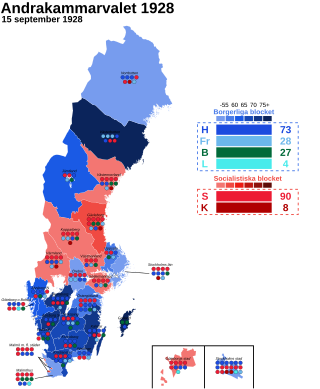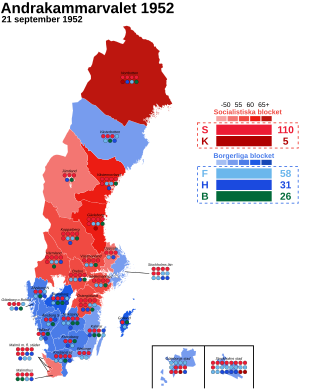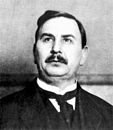
General elections were held in Sweden on 20 September 1998. The Swedish Social Democratic Party remained the largest party in the Riksdag, winning 131 of the 349 seats.

General elections were held in Sweden between 15 and 21 September 1928. The Swedish Social Democratic Party remained the largest party, winning 90 of the 230 seats in the Andra kammaren of the Riksdag. Arvid Lindman of the General Electoral League became Prime Minister, replacing the incumbent, Carl Gustaf Ekman of the Free-minded National Association. The elections have since become known as the "Cossack Election" due to the harsh tone and aggressive criticism used by both sides.

General elections were held in Sweden on 21 September 1952. The Social Democrats remained the largest party with 110 of the 230 seats in the Andra kammaren of the Riksdag and together with the Communist Party of Sweden they got 115 seats and the other parties 115 seats. Tage Erlander and his Social Democratic Party did however form his second government with the Farmers' League already in 1951 and together with that party the Social Democrats now had a majority of 136 seats in the chamber and together with the Communists 141 seats. In the other indirectly elected chamber the Social Democrats had an absolute majority.

General elections were held in Sweden on 16 September 1956. The Swedish Social Democratic Party remained the largest party, winning 106 of the 231 seats in the Andra kammaren of the Riksdag. A Social Democratic-Farmers' League coalition government was formed by Prime Minister Tage Erlander after the election with 125 of the total of 231 seats. Although the non-socialist parties held a majority in the Second Chamber, the Social Democrats held a majority in the First Chamber, so a non-socialist government could not be formed.

General elections were held in Sweden on 15 September 1968. Held in the wake of the crushing of the Prague Spring, it resulted in a landslide victory for the Social Democratic government and Prime Minister Tage Erlander. It is one of two general elections in Swedish history where a single party received more than half of the vote. Erlander would resign the following year after an uninterrupted tenure of 23 years as head of government.

General elections were held in Sweden on 18 September 1994. The Swedish Social Democratic Party remained the largest party in the Riksdag, winning 161 of the 349 seats. Led by Ingvar Carlsson, the party returned to power and formed a minority government after the election. This was the final time the Social Democrats recorded above 40% of the vote before the party's vote share steeply declined four years later and never recovered. The Greens also returned to the Riksdag in the 1994 elections, after a three-year absence.

Early general elections were held in Sweden between 10 and 26 September 1921, the first in Sweden under universal suffrage. The Swedish Social Democratic Party remained the largest party, winning 93 of the 230 seats in the Andra kammaren of the Riksdag. Party leader Hjalmar Branting formed his second government.

General elections were held in Sweden between 3 and 24 September 1911, the first election in Sweden with universal male suffrage. The Free-minded National Association (FL) emerged as the largest party, winning 102 of the 230 seats in the Andra kammaren of the Riksdag.

Early general elections were held in Sweden between 27 March and 7 April 1914, after the Riksdag had been prematurely dissolved by the Cabinet of Hjalmar Hammarskjöld. The General Electoral League emerged as the largest party, winning 86 of the 230 seats in the Andra kammaren. As of 2022, this is the last time a Swedish election has not seen the Social Democrats win a plurality of seats.

Early general elections were held in Sweden 5 and 13 September 1914, the second that year. Although the General Electoral League received the most votes, the Swedish Social Democratic Party emerged as the largest party, winning 87 of the 230 seats in the Andra kammaren, and have managed to remain so in every subsequent Swedish election.

General elections were held in Sweden between 1 and 16 September 1917. The Swedish Social Democratic Party remained the largest party, winning 86 of the 230 seats in the Andra kammaren of the Riksdag. As a result the Rightist Prime Minister Carl Swartz resigned the premiership and was replaced by Liberal leader Nils Edén.
Sweden held a general election on 15 September 1968, to elect the members of the Second chamber of the Riksdag. This was to be the final bicameral Riksdag elected. As of 2020, this was the final time a party has held an outright majority in the Riksdag after the Social Democrats won 125 out of the 233 seats.
Sweden held a general election on the 18 September 1960. 232 seats were filled in the election.
Sweden held an early general election to fulfil the four-year term between the regular 1956 and 1960 elections. Although the centre-right received more votes, the leftist parties won one more seat. The election was held on 1 June.
Sweden held a general election on 16 September 1956. This was the sole election between WWII and 1976 which rendered a centre-right majority in the chamber, although the bicameral system and the majority for the leftist parties in the upper chamber rendered a cross-coalition Social Democrat-Farmers' League government.
Sweden held a general election on 19 September 1948. This was the country's first election since the dissolution of the wartime unity government in 1945, which had consisted of the Social Democrats and all three centre-right parties. The election resulted in the Social Democrats maintaining their 46% share of the vote, securing their position in government. Meanwhile, the centre-right parties made gains at the expense of the Communists, who suffered a significant decline in the overall vote. The People's Party achieved the largest gains of any party, becoming the largest opposition party.
Sweden held a general election on 17 September 1944. Due to the wartime coalition government the bloc balance mainly determined that Per-Albin Hansson remained as Prime Minister, with the four-party coalition remaining in office with 215 out of 230 seats. Among the traditional blocs, the left bloc won 130 and the right bloc 100.
Sweden held a general election around 19 September 1924. This was the second election under universal suffrage. In spite of a majority for the non-socialist parties, Social Democrat Hjalmar Branting was able to form a government, although his successor eventually saw the government fall and being replaced by a right-leaning Electoral League government.
Sweden held a general election around 17 September 1932.
Sweden held a general election in September 1920. The election was the last before universal suffrage was introduced the following year. The Social Democratic Party remained the largest party, winning 75 of the 230 seats in the Second Chamber of the Riksdag. In spite of this, the non-socialist parties got a sizeable majority in the chamber.

















